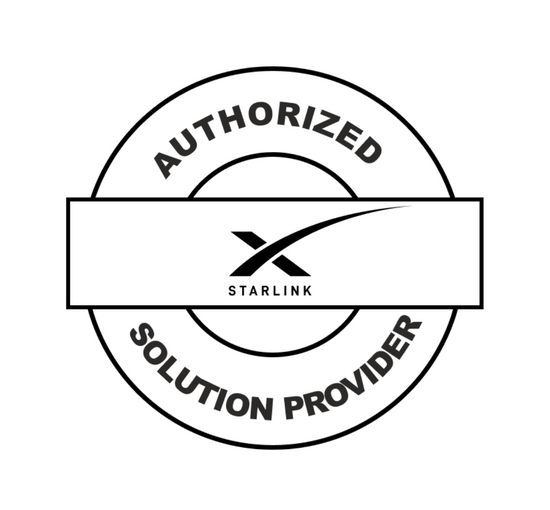
What Is Very Small Aperture Terminal (VSAT)?
VSAT internet is a satellite broadband service that delivers reliable, low-latency internet with high speeds to even the most remote locations, as long as there's a clear view of the sky. A portable VSAT antenna acts like a smaller version of a satellite dish, leveraging satellites to receive and transmit signals.
While VSAT satellite broadband is known as an optimal internet solution for businesses in remote locations, it's important to evaluate its pros and cons to ensure it's the right fit for your business needs.
VSAT Price: What Affects the Cost?
VSAT satellite internet is usually more expensive than traditional satellite and cellular technologies due to its extensive network infrastructure, advanced equipment, and professional installation — with costs ranging from a few thousand to tens of thousands of dollars. And yet, if you require reliable high-speed internet access in remote areas, VSAT’s features can justify the higher costs
-
 Equipment
EquipmentEquipment costs depend on the system type (fixed, portable, or maritime), antenna sizes, and router features
-
 Installation
InstallationProfessional installation costs may vary depending on your location and the setup complexity
-
 Monthly service plan
Monthly service planMonthly service plan costs depend on providers, bandwidth requirements, and chosen data packages
Use Cases for VSAT Satellite Internet
-
 Remote Businesses
Remote BusinessesVSAT connections offer reliable internet access and fast data transfer, wherever your business is located
-
 Maritime
MaritimeMaritime VSAT provides vessels with global coverage, enabling real-time communication, navigation, and monitoring
-
 Logistics
LogisticsVSAT enables real-time tracking and efficient management of your fleets and supply chains, regardless of location
-
 Energy
EnergyVSAT allows for remote monitoring, real-time data transfer, and enhanced operational efficiency, wherever deployed

Advantages of VSAT:
✔ Global Coverage: A VSAT antenna can provide reliable connectivity even in remote and hard-to-reach areas as long as it has a clear view of the sky;
✔ Reliable Connectivity: VSAT internet is not prone to cable cuts or natural disasters, providing a more reliable and consistent internet connection;
✔ Scalability: You can easily expand VSAT network to meet growing bandwidth requirements as your business grows;
✔ Diverse Use Cases: VSAT supports VoIP, IoT, and real-time data transfer in remote locations — ideal for industries like maritime, oil & gas, and more.

Disadvantages of VSAT:
✔ Higher latency: VSAT internet, leveraging GEO satellites, has higher latency than LEO satellite internet, which results in slower data transfer;
✔ Lower Bandwidth & Speed: VSAT offers lower bandwidth and slower speeds than LEO satellites, resulting in reduced performance;
✔ Higher Costs: VSAT equipment, installation, and ongoing service costs are typically higher than those of LEO satellite internet;
✔ Less Weather-Resistant: VSAT is more prone to weather conditions than LEO satellites, which results in service interruptions.
-
Ku-Band VSAT (12-18 GHz)
✔ High speeds: Faster data rates via higher frequencies;
✔ Global coverage: Powered by a vast satellite network;
✔ Reliable: Low ground interference, but weather-sensitive;
✔ VSAT installation: Affordable, easy-to-install VSAT terminals

-
C-Band VSAT (4-8 GHz)
✔ Weather-resistant: Rain-resistant, prone to ground interference;
✔ Wide coverage: Continential cover, ideal for remote areas;
✔ Highly Reliable: Consistent, high-performance connectivity
✔ Moderate speeds: Lower data rates via lower frequencies


Why Does DROAM Not Offer VSAT Broadband?
Nowadays, LEO satellite providers have emerged as strong competitors to traditional VSAT systems. Powered by low-earth orbit satellites, cost-effective satellite internet from DROAM offers significantly lower latency, higher bandwidth, and faster speeds, enhancing overall performance for real-time applications in remote marine areas.
With these new players entering the market, VSAT’s limited coverage, higher latency, and greater costs make it less appealing for remote businesses that require consistent, high-performance connectivity with the ability to scale.
Which Alternatives Do We Recommend?
-

Low-Earth Orbit (LEO) Satellite Internet
LEO satellites deliver reliable, high-performance connectivity with faster speeds, lower latency, and broader coverage than VSAT, offering a more scalable and cost-effective solution for businesses in remote areas
-

Cellular Terrestrial Wireless
If coverage allows, cellular terrestrial wireless (4G LTE, 5G) offers a superior, cost-effective alternative to VSAT, specifically due to its significantly lower latency, blazing-fast speeds, enhanced reliability, and greater scalability
-

"I've worked with DROAM since the beginning of the company and I've experienced the rapid growth first hand. This is mainly because of the great knowledge and problem solving expertise of the team. I'm happy to work with such a trustfull, transparent, and reliable team of experts. Many collaboration years to come!"
Wesley Kelder, CEO of XIPO Connect

-

"DROAM is known for their expertise in providing secure, reliable and scalable marine internet options and systems. This aligns well with the growing demand for flexible and robust marine satellite internet near me. We are very happy to have a strong partnership with DROAM. The team has always helped us achieve our goals and we appreciate all the work that has been done to accomplish our common goals!"
Aziz El Bouazzati,Senior Sales Executive at Frontier

-

"All around Europe, the Middle East, India, Singapore, US, and the service worked perfect (except for Amman in Jordan where there were some hickups).
I used it constantly and the resulting cost for those three months was a fraction of what I would normally have to pay, while my T-Mobile roaming data bill remained at $0.00"
Werner Vogels, CTO at Amazon







































